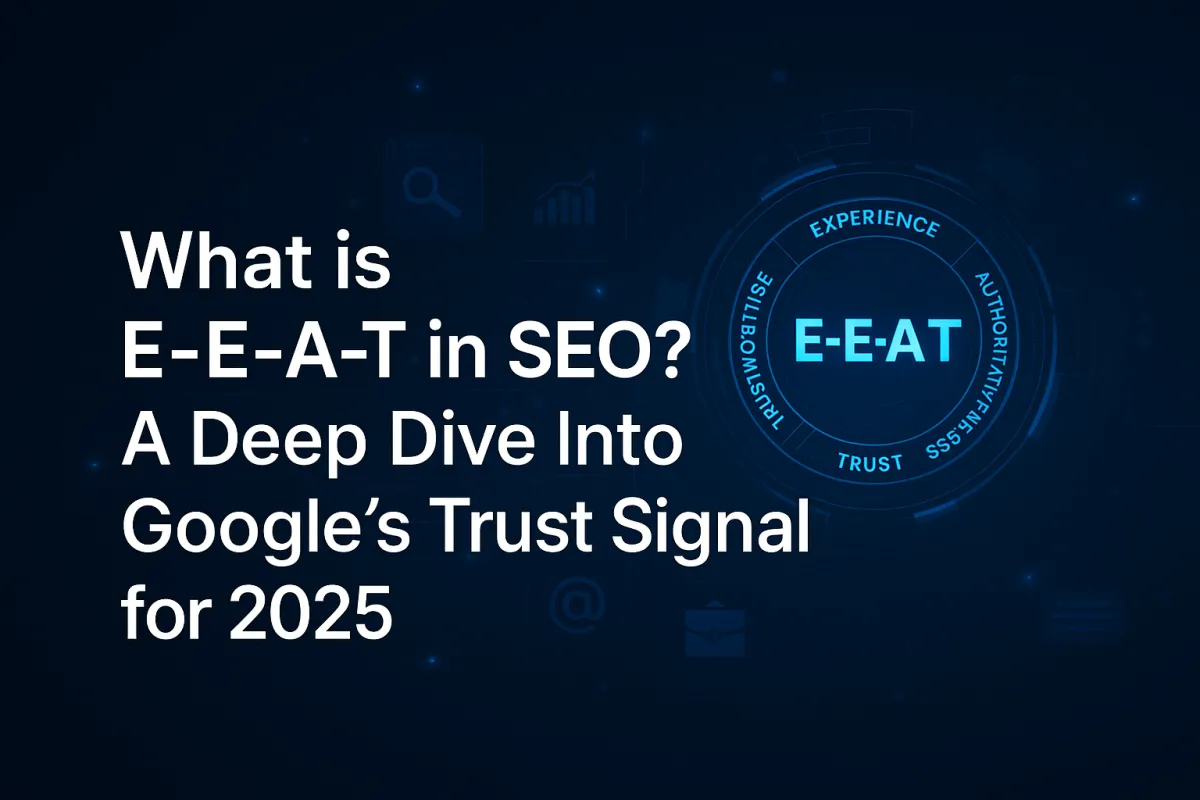
What is E-E-A-T in SEO? A Deep Dive Into Google's Trust Signal for 2025
TL;DR — What You Need to Know
Google’s E-E-A-T framework is a set of quality signals used to evaluate content, websites, and authors. It stands for Experience, Expertise, Authoritativeness, and Trustworthiness. If you want to rank consistently—especially for competitive or YMYL (Your Money or Your Life) queries—your content must demonstrate all four. In this guide, you’ll learn what each component means, why it’s crucial, and how to implement it across your website.
🎯 Why E-E-A-T Matters (Especially in 2025)
SEO has evolved. In the early days, keyword stuffing and backlinks were enough to dominate Google. Today, algorithm updates like Helpful Content, Core Updates, and the Product Review system make it clear: Google wants to reward content that is trustworthy, written by knowledgeable people, and backed by real-world experience.
In other words—content that truly helps users.
And this is exactly where E-E-A-T comes in.
If your website or business is in a niche that impacts someone’s money, health, safety, or future (think: finance, legal, medical, supplements, home security, etc.), then E-E-A-T isn’t optional—it’s essential.
📘 What Does E-E-A-T Stand For?
Let’s break it down:
🔹 Experience (Added December 2022)
Google wants to see content from people who’ve been there, done that. Not just regurgitating what others said.
✅ Examples of “Experience” in Practice:
A fitness coach showing photos of their transformation while writing about fat loss.
A business owner writing a case study about their lead generation process.
A makeup artist reviewing a product they’ve personally used (with photos or videos).
A Shopify store owner blogging about what worked in their ad campaigns.
TIP: Ask yourself, “Could this only be written by someone who’s actually done it?” If not, go deeper.
🔹 Expertise
This refers to the author’s knowledge or credentials in the topic they’re writing about. Expertise can be formal (degrees, certifications) or informal (years of experience, niche specialization).
✅ How to Show Expertise:
Author bio that includes credentials, certifications, or achievements.
Mentioning years of experience (“With over 10 years in cybersecurity…”).
Linking to authoritative guest posts or publications authored elsewhere.
Including niche jargon or data that proves insider knowledge.
Pro Tip: Even if you’re not a PhD, you can still be an expert—especially if your insights come from hands-on work.
🔹 Authoritativeness
Authority is about how others see you in your space. It’s a combination of brand reputation, backlinks, citations, and mentions from authoritative websites or users.
✅ Signs of Authority:
Being featured on major sites (Forbes, HubSpot, BBC).
Earning quality backlinks from relevant, trusted domains.
Active community presence (e.g., speaking at events, quoted in media).
Strong engagement on professional platforms like LinkedIn or YouTube.
Pro Tip: Authority builds over time. It’s a compound effect—consistent high-quality content, good PR, and strong branding all contribute.
🔹 Trustworthiness
Trust is the core of E-E-A-T. Without it, everything else falls apart. Google wants to promote websites that are safe, reliable, and transparent.
✅ How to Build Trust:
Use HTTPS and display trust signals (badges, reviews, awards).
Show author names, photos, and bios on content.
Have a clear About page, Privacy Policy, Terms of Service, and Contact page.
Feature real reviews/testimonials and business addresses.
Use proper spelling, grammar, and fact-checking.
Real Example: A health blog with no author info or contact details will score poorly on trust, even if the content is accurate.
🛠️ How to Implement E-E-A-T on Your Website (Step-by-Step)
Here’s a practical checklist you can follow—whether you’re running a blog, e-commerce store, or service-based business.
✅ Content-Level
Add author bios on all blog posts.
Include personal experience, photos, or anecdotes in how-to guides or product reviews.
Use first-person language where appropriate (“I tested this tool…”).
Link to sources, stats, and original research.
Avoid AI-sounding or generic content—be real, specific, and useful.
✅ Author & Branding
Create detailed author pages with credentials and links to other work.
Use your real name and photo (or that of a team member).
Publish long-form expert content—not fluff.
Get active on authority-building platforms (e.g., Quora, Medium, HARO).
✅ Website-Wide
Use HTTPS.
Display your physical business address if applicable.
Add a Trustpilot, Google Reviews, or Yotpo widget.
Ensure consistent NAP data across your site and citations.
Keep your About, Contact, Privacy, and Terms of Service pages updated and accessible.
📈 Bonus: How E-E-A-T Impacts Rankings (With Real Data)
Sites that implement E-E-A-T properly often see improvements in:
Featured snippet wins
Top 3 rankings for YMYL keywords
Time on page and bounce rate (because the content builds trust)
Conversion rates, especially in niches like law, health, finance, and e-commerce
Example: After adding author bios, improving internal linking, and showcasing trust badges, one of our clients in the personal finance niche saw a 37% increase in organic traffic in 60 days—without any new backlinks.
🚀 Final Thoughts: E-E-A-T Is the Future of SEO
If you’re serious about long-term SEO success, E-E-A-T is your blueprint. Google will continue to refine how it evaluates trust and authority. The businesses that win will be the ones that:
Focus on quality over quantity
Build a real brand
Speak from experience
Put the user first
It’s not about gaming the algorithm anymore. It’s about being the best result on the internet.
💡 Want Help Implementing E-E-A-T?
If you’re not sure how to showcase experience, build trust signals, or earn authority backlinks, I can help. Reach out and let’s talk about your SEO goals.
E-E-A-T SEO Checklist (2025 Edition)
🟦 Experience
Ensure the author or brand demonstrates first-hand involvement with the topic.
Use real-world examples, case studies, or photos/screenshots.
Include personal stories or outcomes related to the product/service/topic.
Add original research, experiments, or unique data where possible.
Embed reviews, testimonials, or user-generated content to support experience.
Highlight practical usage tips only someone with hands-on experience would know.
🟩 Expertise
Show that the content creator is knowledgeable and qualified on the subject.
Write content in a niche where you (or your brand) have proven credibility.
Include author bios with relevant experience, qualifications, or industry recognition.
Link to other authoritative articles or publications the author has written.
Get guest contributors who are known experts, if possible.
Avoid generic content—aim for depth and accuracy over word count.
🟨 Authoritativeness
Establish your website and authors as go-to sources in your industry.
Get backlinks from trusted websites in your niche (digital PR, guest posts, HARO, etc.).
Be referenced or cited in industry roundups, forums, or other credible media.
Build your brand presence on platforms like LinkedIn, YouTube, and Google Business.
Encourage satisfied customers to leave reviews on third-party sites (Google, Trustpilot).
Ensure consistent NAP (Name, Address, Phone) data across the web.
🟥 Trustworthiness
Make your site and content feel safe, reliable, and legitimate.
Use HTTPS (SSL certificate installed).
Display clear contact information and a physical address (if applicable).
Include an up-to-date About page, Terms of Service, and Privacy Policy.
Mention how data is collected and used (especially important for EU/UK users—GDPR).
Keep content updated, especially on YMYL (Your Money, Your Life) topics.
Moderate and respond to blog comments and reviews to show active engagement.
🔄 Site-Wide Signals That Improve E-E-A-T
Schema markup for authors, reviews, and business details.
Regular blog publishing schedule to show consistency.
Fast-loading, mobile-friendly website.
Clear branding (logo, colors, tagline) throughout the site.
Use of editorial standards or content publishing guidelines.
